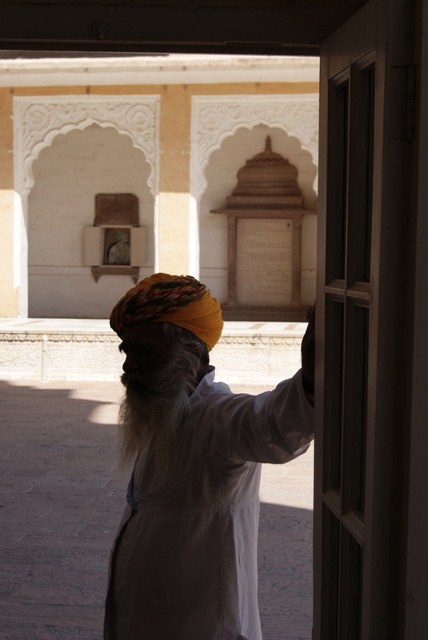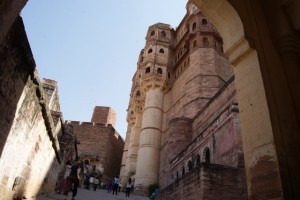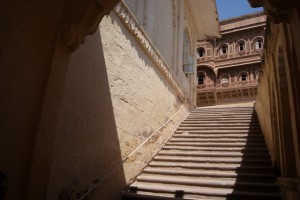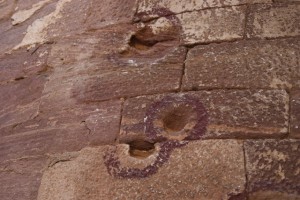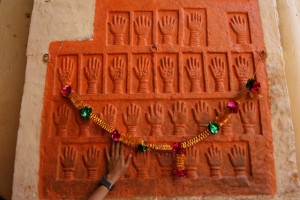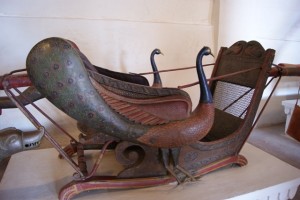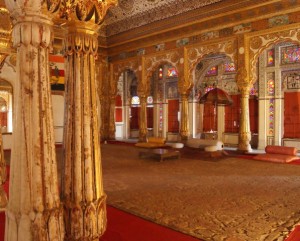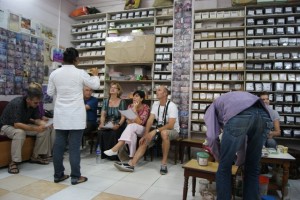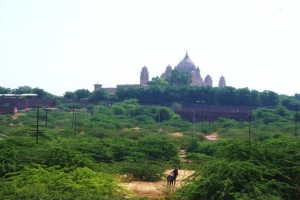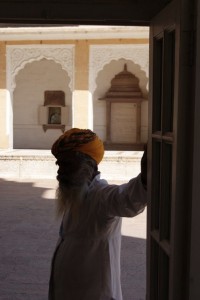Paul Theroux said that ‘the conceit of the long distance traveller is the belief that he is going so far he will be alone’. Starting from Delhi on an early weekend morning, I must say I was conceited – I was going to drive 600 kilometres, which would take the better part of the day to reach Jodhpur. So I was mildly appalled when I found that there were many like me – though some were heading to Jaipur, most dropped out after Ajmer, both along the way. Anyway my conceit was ill-fated: roaming the forts and bazaars the next day, I found the place teeming with tourists and history enthusiasts, honeymooners and schoolchildren on study tours. As with most histories of the sword and dagger era, the Mehrangarh Fort too has one of mystery and dark intrigues. Rao Jodha, a Rajput chief belonging to the Rathore dynasty and founder of Jodhpur, laid the foundation of the fort in 1459 in a rocky mesa known as Bhaurcheeria meaning ‘hill of the birds’. One problem though: a hermit called Cheeria Nathji – lord of the birds – had already made his nest up there and refused to relocate. Left with no other option, the hermit was forcibly evicted. He left screaming a curse that the palace would never have enough water – last thing anyone would want in a desert abode. Though Jodha won the wrathful hermit over by building a house for him within the fort itself, some believe that the severe droughts the region goes through every three of four years is an aftermath. To ward off the jinx, Jodha now took the extreme step of human sacrifice: a loyal subject called Rajiya was buried alive in the foundation. Though the poor soul’s family was provided for by the ruling Rathores, Jodha now, in addition to vengeful ascetics and recurring droughts, had blood in his hands as well. Well, minor impediments to a grand dream. The magnificence of the scale dawns on you right as you step inside the premises through the Jai Pol or ‘victory gate’ built in 1806 by Maharaja Man Singh to mark his victory over Jaipur. Sprawled over an expanse of five sq.km, the fort’s walls in some parts, especially near the entrance, towers above 36 metres and is 21 metres wide. Before you think paranoia, red markings outside the spiked iron gates show where enemy cannons left indelible indentations. Definitely a victory worth a regal entry! I walked in with my chest puffed out, trying to relive those ‘Man Singh moments’. Vibrant notes wafted down from a couple of rustic musicians who were recreating desert music, aiding my endeavours greatly. But as I neared the Loha Pol which is the last fortified entry into the main fort complex, I saw this red patch on the wall with hand imprints which made me happy that I was only an impersonator. These were sati marks, left behind by the wives of Man Singh, who immolated themselves in the cremation fire of their husband in 1843. I counted 30 palms; say each one left a pair of impressions, that meant 15 jumped into the fire! “Some real love here,” I remarked pointedly to my wife.
“Build me a palace and we will talk,” she shot back.
Whether you choose to arm yourself with an audio guide available at the entrance or with your own set of references (if you are hiring one of the guides from the entry point for the fixed rate of Rs 100, I suggest you offer to pay some extra at the very outset or he will rush you), the next few hours is a walk through period, where, with some imagination, it will even come alive and transport you there. I walked by the Shringar Chowk, where coronation ceremonies took place, looked up and saw the queen mother beaming down from the ladies’ quarters. One of the exquisitely crafted palanquins was called ‘Tamzam’ or ‘naughty boy’ – and it was easy to see a fidgety little blue blood who would rather ride his favourite pony. The lion-embossed elephant howdah was a gift from Shah Jahan to the first Maharaja Jaswant Singh. The description says that the framework is covered with polished silver sheet and decorated with repousse work. It is divided into three sections – the royal seat, an intervening section which has a hinged door for passage and a rear high-backed seat for bodyguard. We all know the architectural marvel, but how many of us know these little design feats! The women who lived within these ramparts not only loved their husbands, well, dearly, but also adhered to an exercise regiment. A long trumpet-shaped instrument with a grip knob was a Mudhgar or ladies’ dumbbell. Did the ranis run a wager on who could do the maximum reps? I realised that the curves on artistic renditions of queens of yore were not entirely creative licenses. Going through the swords section, I learnt that spathology was the study of historical swords and skiligars were those who made them. The Talapura sword with its hilt terminating in a dragon, which in turn held a rabbit in its jaws, made me want to change jobs…be a spathologist. My fantasies climaxed at the grandest of them all – the Phool Mahal (Palace of Flowers), built by Maharaja Abhay Singh – which, ‘with its delicate colours, golden sheen, ornate ceiling and stained glass, is the grandest period room in Mehrangarh’. Though no one knows the exact purpose of this room, my favourite version is that it is a chamber of pleasure. Renowned dancers from all over the country used to perform here for the king and his select few. No stones were left unturned to ensure that this was a dedicated pleasure spot – even the ceilings are embellished with gold-hued filigree, polished to reflection. Before notions of nobility went to my head, I decided to mingle with the man on the street and went to see the Clock Tower in the old city. The Sadar Bazaar which sprouts in all directions from this landmark is popular with those hunting for handicrafts and curios. Also with those who want a slice of the ethnic. Travel companies organise ‘spice trails’ where the importance of spice in India, how they taste, smell and feel are explained within an hour-long workshop. Not exhaustive but definitely an informative exercise. I sat for one with a bunch of aahing and aachooing tourists conducted by a spice shop which boasted a lineage of over a century. The next day we visited the Jaswant Thada, a memorial in white marble for Maharaja Jaswant Singh. The cenotaph is prettier from a distance – with the reflection in the lake bringing out the poignancy of the memoir it is. The highlight of our visit to the Umaid Bhawan Palace was the neel gai – which we spotted during one of the numerous rounds we made looking for the visitor entrance. I ran after it with my camera. In five minutes my tee was in tatters and there were bloody scratches all over me from the thorny bushes the gai gambolled over. After panting shots of the flanks and the shanks, it paused at a distance and looked back at me with a smirk. The picture was a fitting tribute to the reverie Jodhpur with its mysterious and glorious, sinister and illustrious history transported me to. A graceful animal, revered as a harbinger of good luck against the sandstone domes and spires of the palace of a living king.
Wanderink recommends: There is not much going for the Umaid Bhawan Palace except that you go around in circles looking for the right entry – half the time you end up at the Taj hotel (which takes up part of the palace) and the other half you ask recently transferred army jawans who has the faintest idea. With the sun blazing down like in any other desert city, it would augur well for tourism if the forts have a covered parking facility for visitor cars. There is smoke each time we get back into our cars.


